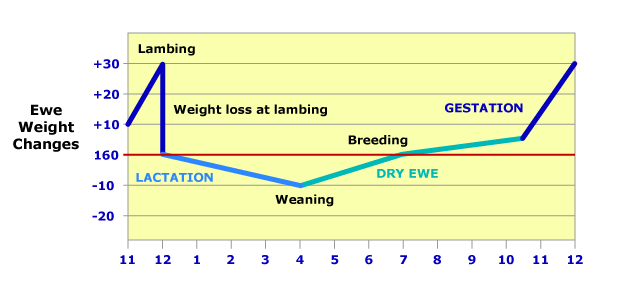Previous Page | Right click this page to print.
Biological Cycle and Requirements of the Ewe
One of the things that, to kind of give us a perspective of some key times from the standpoint of nutritional requirements, is to look at the biological cycle of the ewe from the standpoint of stage of production and the duration or amount of time that she’s in these various stages throughout the year.
Stage
of Production |
Duration (Days) |
|---|---|
Breeding (Flushing)
|
34 |
Gestation (1st
15 weeks) |
85 |
Late Gestation
(6 weeks) |
42 |
Parturition |
1 |
Lactation (1st
8 weeks) |
53 |
Late Lactation |
35 |
Maintenance |
115 |
If we put in all the figures...And starting out with breeding, we’ve one key time at breeding where we have our flushing period and this is about 17 days prior to the start of the breeding season and then it runs about 17 days into the breeding season. Then, we have our gestation period of the first 15 weeks which is 85 days, late gestation about 42 days. We have a day of parturition. Then, we have lactation, first 8 weeks which is critical, then, the remainder portion of lactation is going to vary from production system. Some people, some operations wean as early as 8 weeks of age, others go longer and so that amount of time varies from operation to operation. Then, of course we have maintenance which runs about 115 days. If you add those up, that should come close to 365 days.
Some key times that we want to spend some time talking about relates to breeding, flushing, late gestation and then the lactation period, the first 8 weeks.
Weight changes normally expected in a year for a 160 lb. ewe giving birth to and rearing twin lambs

If we look at what’s happening in weight changes of the ewe over this biological cycle, coming in the last 6 weeks of gestation we have an increasing rate of body weight gain during this time period. Then, of course, lambing, loss of that weight because it’s fetal growth primarily along with placental tissue. Then, at lactation we expect body weight to decline, gain it back at weaning, so then they are about up to their normal maintenance weight at breeding, with a slow growth at that early trimester or the early two-thirds and then followed by the late gestation increase in growth and that’s primarily related to the fetus.
Let’s talk about the various stages then. These are the ones we
are going to spend some time with, flushing first of all, then we’ll
talk about late gestation and then lactation, from the standpoint of diet
formulation and balancing ewe rations during this time of the production
stage.
Previous Page | Right click this page to print.